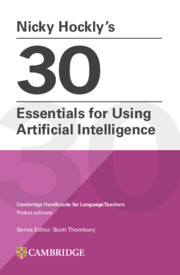Summary
This first section aims to demystify artificial intelligence (AI) by explaining in a very basic sense what AI is, and how it works. We also consider how and why EdTech is prone to hype, and how we and our learners might resist this hype.
1 What is AI?
2 What is generative AI?
3 AI and language learning
4 AI and creativity
5 Technology and the hype cycle
What is AI?
The field of artificial intelligence (AI) aims to create digital machines that can carry out tasks that typically need human intelligence. How close are we to human-level artificial intelligence?
Early AI in language teaching With the amount of hype and hysteria that surrounded the arrival of ChatGPT in late 2022, you’d be forgiven for thinking that AI is a completely new technology for teachers and learners. Not so. The earliest and simplest forms of AI in ELT can be traced back to the 1960s, when CALL (Computer Assisted Language Learning) emerged as an area of study. In these early days of AI, computers could be programmed to provide limited responses to prompts. Computers were large and expensive, and tended to be found in universities. The advent of the personal computer, however, meant that by the late 1980s and early 1990s computers began to appear in schools and in people's homes. Language learning software with simple gap-fill and text reconstruction activities became available. As computing power increased, and computers developed multimedia capabilities, other uses for AI in language learning emerged. This was the heyday of the CDROM. By the early 1990s, some language learning software began to integrate voice recognition to support pronunciation. Since then, AI has become more powerful, and technology – especially in the form of mobile devices – has become more ubiquitous.
Narrow versus artificial general intelligence
To understand where AI has come from and where it is going, it is useful to distinguish narrow (or weak) and strong AI – the latter is usually referred to as artificial general intelligence or AGI. Here an analogy may be helpful. Imagine a chair that is mass-produced in a factory.
- Type
- Chapter
- Information
- Publisher: Cambridge University PressPrint publication year: 2024

